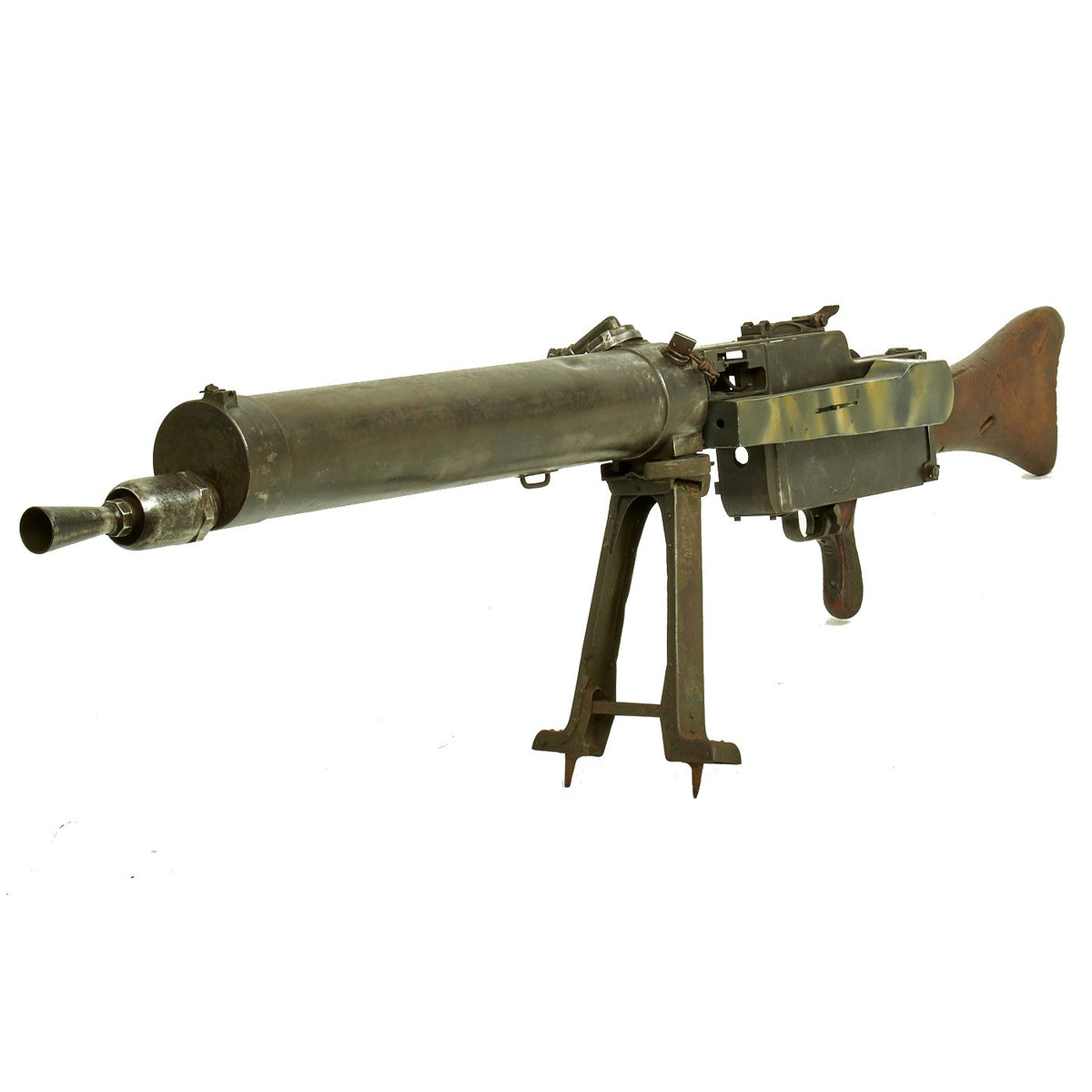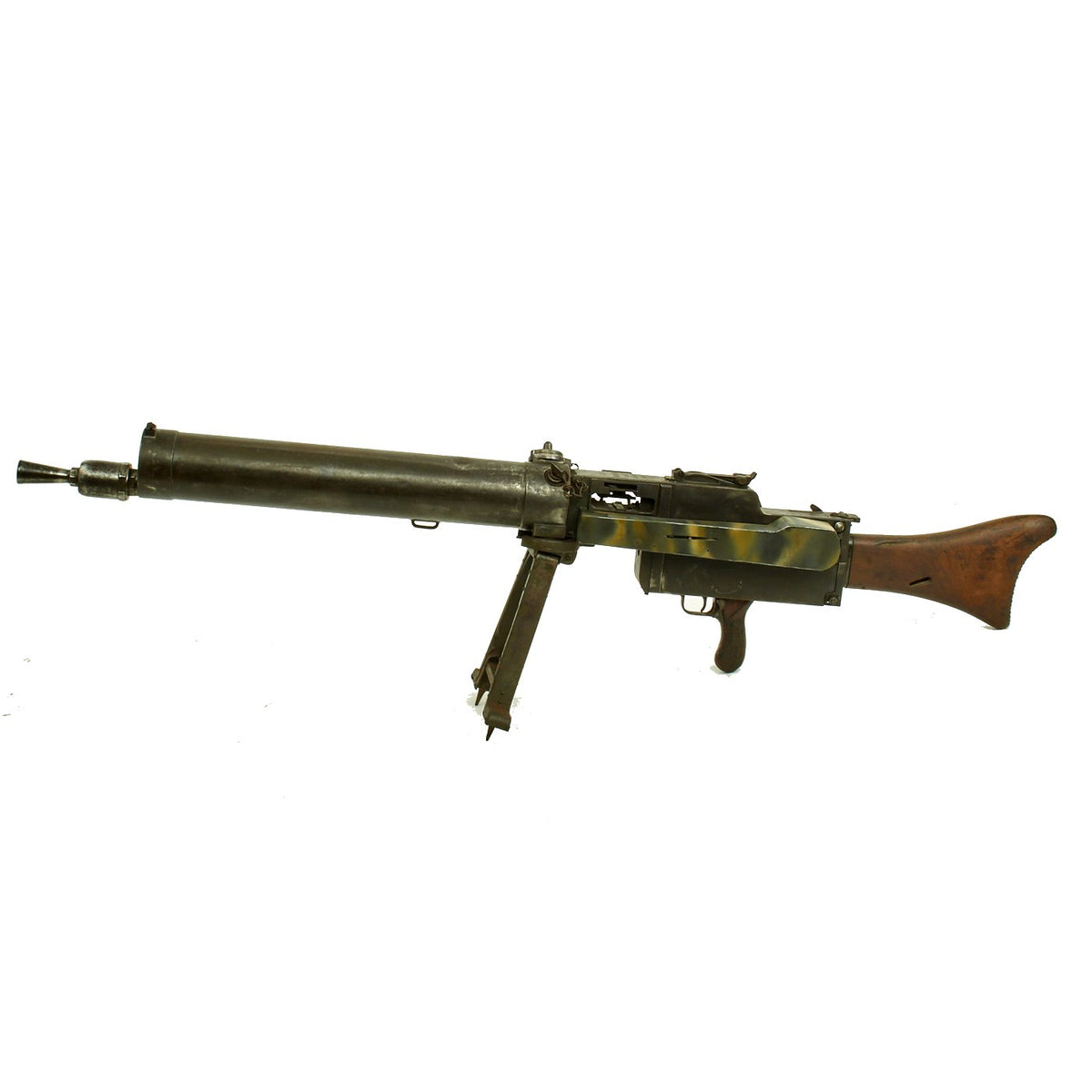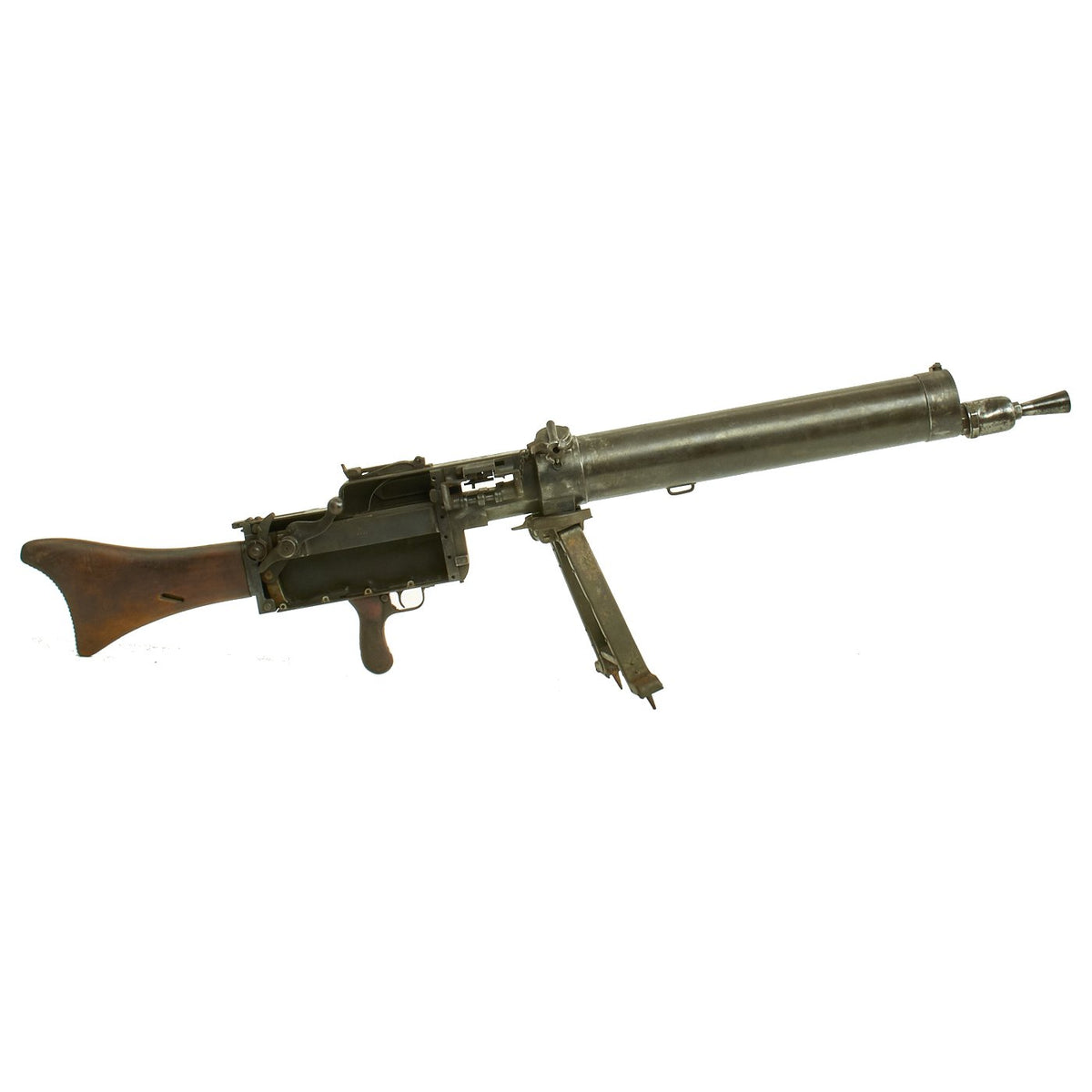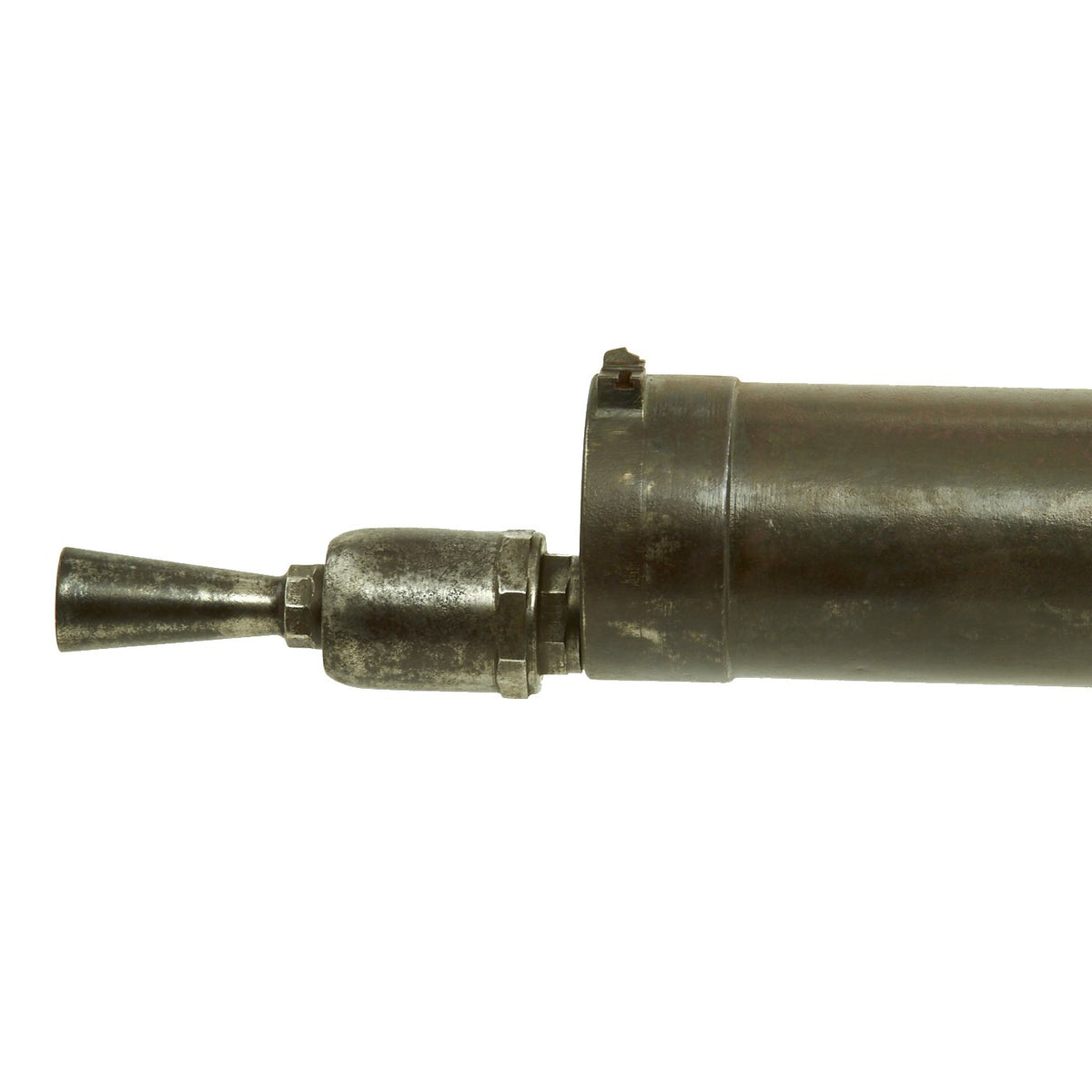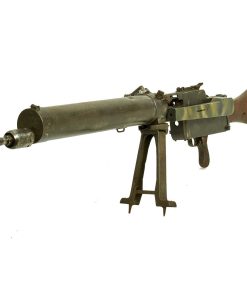Original German WWI Maxim MG 08/15 Display Machine Gun Parts Set by Siemens & Halske – Dated 1918 Original Items
$ 4.995,00 $ 1.248,75
Original Item: Only One Available. This is a fine example of the legendary German Maxim Maschinengewehr (Machine Gun) 08/15, known as the MG 08/15, complete with a very rare original bipod. This gun became, by far, the most common German machine gun deployed in World War I (Dolf Goldsmith, 1989) since it reached a full allocation of six guns per company or 72 guns per regiment in 1918. By that time, there were four times as many MG 08/15 light machine guns than heavy MG 08 machine guns in each infantry regiment. This fine example is covered with markings and proofs, and is nicely marked on the top cover:
8583
M.G. 08/15.
S. & H.
BERLIN.
1918.
Siemens & Halske of Berlin were one of several contractors aside from the Government Arsenals at Spandau and Erfurt to manufacture the MG 08/15. They produced approximately 13,000 of the machine guns, the 4th largest producer. The company was mostly involved in communications engineering, and later became part of the larger Siemens company.
The top cover is marked with serial number 8583, and the top latch is matching, as are almost all of the other original components, including the barrel jacket, feed tray, crank handle, and other components. This was made from what was at least a partial if not totally matching example. It even has an original steam port cover, which is also marked with shortened number 583! That means this is the original cover it was issued with, at the factory! There are lot of other markings and proofs on this example, typical of WWI German production.
This is a complete and fully BATF approved inert non-firing display gun for the advanced collector. This fine example was built from all original parts and is offered in fine condition with multiple German markings and serial numbers. We have not installed a right side plate, so that the lovely internal structure and complete barrel extension can be seen.
Only the fusee spring cover is a reproduction, which we custom fabricated in house. Please note that there are a few combat dents to the bipod and water jacket, but this is overall a really nice display piece from over 100 years ago. Most internal parts are included and are complete. The lock is however not included.
History of the MG 08-
The Maschinengewehr 08, or MG 08, was the German Army’s standard machine gun in World War I and is an adaption of Hiram S. Maxim’s original 1884 Maxim gun. It was produced in a number of variants during the war. The MG 08 served during World War II as a heavy machine gun in many German infantry divisions, although by the end of the war it had mostly been relegated to second-rate fortress units.
The Maschinengewehr 08 (or MG 08) – so-named after 1908, its year of adoption – was a development of the license made Maschinengewehr 01. It could reach a firing rate of up to 400 rounds per minute using 250-round fabric belts of 7.92x57mm ammunition, although sustained firing would lead to overheating; it was water-cooled using a jacket around the barrel that held approximately one gallon of water. Using a separate attachment sight with range calculator for indirect fire, the MG 08 could be operated from cover. Additional telescopic sights were also developed and used in quantity during the war.
The MG 08, like the Maxim gun, operated on the basis of short barrel recoil and a toggle lock; once cocked and fired the MG 08 would continue firing rounds until the trigger was released (or until all available ammunition was expended). Its practical range was estimated at some 2,000 metres (2,200 yd) up to an extreme range of 3,600 metres (3,900 yd). The MG 08 was mounted on a sled mount (German: Schlittenlafette) that was ferried between locations either on carts or else carried above men’s shoulders in the manner of a stretcher.
Pre-war production was by Deutsche Waffen und Munitionsfabriken (DWM) in Berlin and the government arsenal at Spandau (so that the gun was often referred to as a Spandau MG 08).
A lightened and thus more portable version – by “stepping-down” the upper rear and lower forward corners of the original MG 08’s rectangular-outline receiver and breech assembly – was tested as a prototype in 1915 by a team of weapon designers under the direction of a Colonel Friedrich von Merkatz: the MG 08/15. The MG 08/15 had been designed to be manned by four trained infantrymen spread on the ground around the gun and in the prone position. To accomplish that purpose the MG 08/15 featured a short bipod rather than a heavy four legged sled mount, plus a wooden gunstock and a pistol grip. At 18 kg, the MG 08/15 was lighter and less cumbersome than the standard MG 08 since the MG 08/15 had been designed to provide increased mobility of infantry automatic fire. It nevertheless remained a bulky water-cooled weapon that was quite demanding on the quality and training of its crews. Accurate fire was difficult to achieve and usually in short bursts only. It was first introduced in battle during the French “Chemin des Dames” offensive in April 1917 where it contributed to the very high casualty count among the French assailants. Its deployment in increasingly large numbers with all front line infantry regiments continued in 1917 and during the German offensives of the spring and summer of 1918. The MG 08/15 became, by far, the most common German machine gun deployed in World War I (Dolf Goldsmith, 1989) since it reached a full allocation of six guns per company or 72 guns per regiment in 1918. By that time, there were four times as many MG 08/15 light machine guns than heavy MG 08 machine guns in each infantry regiment. To attain this goal, about 130,000 MG 08/15 had to be manufactured during World War I, most of them by the Spandau and Erfurt government arsenals.
Fast Shipping with Professional Packaging
Thanks to our longstanding association with UPS FedEx DHL, and other major international carriers, we are able to provide a range of shipping options. Our warehouse staff is expertly trained and will wrap your products according to our exact and precise specifications. Prior to shipping, your goods will be thoroughly examined and securely secured. We ship to thousands clients each day across multiple countries. This shows how we're dedicated to be the largest retailer on the internet. Warehouses and distribution centres can be located throughout Europe as well as the USA.
Note: Orders with more than one item will be assigned a processing date depending on the item.
Before shipping before shipping, we'll conduct a thorough inspection of the items you have ordered. Today, the majority of orders will be delivered within 48 hours. The delivery time will be between 3-7 days.
Returns
The stock is dynamic and we cannot completely manage it because multiple stakeholders are involved, including our factory and warehouse. So the actual stock may alter at any time. It's possible that you may not receive your order once the order has been made.
Our policy is valid for a period of 30 days. If you don't receive the product within 30 days, we are not able to issue a refund or an exchange.
You can only return an item if it is unused and in the same state as the day you received it. You must have the item in its original packaging.
Related products
Uncategorized
Uncategorized
Uncategorized
Uncategorized
Uncategorized
Uncategorized
Uncategorized
Uncategorized
Uncategorized
Uncategorized
Uncategorized
Uncategorized
Uncategorized
Uncategorized
Angolan Rebel 1970s era 60mm Inert Display Mortar from Angolan Civil War Original Items
Uncategorized
Uncategorized
Uncategorized
Armored Burgonet Helmet & Polearm from Scottish Castle Leith Hall Circa 1700 Original Items
